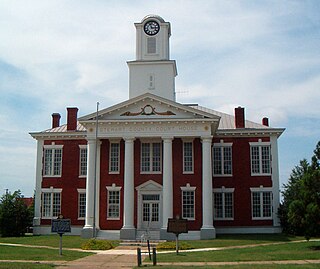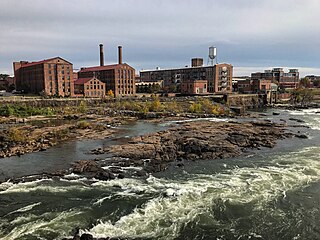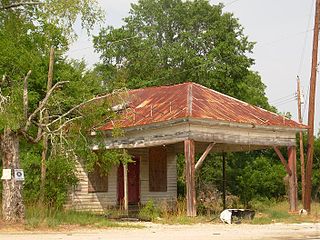History
Named after Philadelphia-based banker Stephen Girard, who had purchased much of the Muscogee territory that would become Russell County, [3] the town of Girard served as the county's first seat from 1832 to 1839. It was incorporated around 1833. Girard was the site of Fort Ingersoll, built during the Creek War of 1836 to protect white interests in the area. The town saw much of the fighting in the 1865 Battle of Columbus, culminating in the burning of the Dillingham Street bridge by retreating Confederates, and the eventual capture of Columbus.
After Alabama prohibited alcohol sales in 1915, Girard became a center of bootlegging. Even after prohibition had ended, Girard and Phenix City remained known for gambling and vice establishments, fueled by the growth of Fort Benning (now renamed Fort Moore) across the river. [4]
In 1923 Girard merged with neighboring Phenix City. In 1933, the boundary of Russell County was moved north to take in all of Phenix City that had previously been in Lee County. [5]
Demographics
Historical population| Census | Pop. | Note | %± |
|---|
| 1850 | 748 | | — |
|---|
| 1900 | 3,840 | | — |
|---|
| 1910 | 4,215 | | 9.8% |
|---|
| 1920 | 4,942 | | 17.2% |
|---|
|
Girard first appeared on the 1850 U.S. Census as an incorporated community of 748 residents. Oddly, despite being a large center of population for the time, exceeding an estimated 1,000 residents after 1860, it was not separately returned on the census again until 1900 when it had nearly 4,000 residents.
For reference purposes, the population of the Girard Beat/Precinct, which included the town between 1870 and 1900 was as follows: 1870=3,984; 1880=4,637; 1890=5,486; 1900=6,440. [7]
It formally ceased to exist in 1923 with its merger with Phenix City.

Clarke County is a county located in the southwestern part of the U.S. state of Alabama. As of the 2020 census, the population was 23,087. The county seat is Grove Hill. The county's largest city is Jackson. The county was created by the legislature of the Mississippi Territory in 1812. It is named in honor of General John Clarke of Georgia, who was later elected governor of that state.

Lee County is a county located in east central Alabama. As of the 2020 census the population was 174,241. The county seat is Opelika, and the largest city is Auburn. The county was established in 1866 and is named for General Robert E. Lee (1807–1870), who served as General in Chief of the Armies of the Confederate States in 1865. Lee County comprises the Auburn-Opelika, AL Metropolitan Statistical Area, which is included in the Columbus-Auburn-Opelika, GA-AL Combined Statistical Area.

Russell County is a county in the southeastern part of the U.S. state of Alabama. As of the 2020 census, the population was 59,183. Its county seat is Phenix City. Its name is in honor of Colonel Gilbert C. Russell, who fought in the wars against the Creek Indians.

Stewart County is a county located in the west central portion of the U.S. state of Georgia. As of the 2020 census, the population was 5,314. The county seat is Lumpkin. The county was created on December 23, 1830.

Muscogee County is a county located on the central western border of the U.S. state of Georgia named after the Muscogee that originally inhabited the land with its western border with the state of Alabama that is formed by the Chattahoochee River. As of the 2020 census, the population was 206,922. Its county seat and only city is Columbus, with which it has been a consolidated city-county since the beginning of 1971.

Chattahoochee County, also known as Cusseta-Chattahoochee County, is a county located on the western border in central Georgia. As of the 2020 census, the population was 9,565. The county seat is Cusseta, with which the county shares a consolidated city-county government. The city of Cusseta remains a geographically distinct municipality within Chattahoochee County. The county was created on February 13, 1854.

Eufaula is the largest city in Barbour County, Alabama, United States. As of the 2010 census the city's population was 13,137.

Wetumpka is a city in and the county seat of Elmore County, Alabama, United States. At the 2020 census, the population was 7,220. In the early 21st century Elmore County became one of the fastest-growing counties in the state. The city is considered part of the Montgomery Metropolitan Area.

Phenix City is a city in Lee and Russell counties in the U.S. state of Alabama, and the county seat of Russell County. As of the 2020 Census, the population of the city was 38,817.

Columbus is a consolidated city-county located on the west-central border of the U.S. state of Georgia. Columbus lies on the Chattahoochee River directly across from Phenix City, Alabama. It is the county seat of Muscogee County, with which it officially merged in 1970; the original merger excluded Bibb City, which joined in 2000 after dissolving its own city charter.

Marvyn, also spelled Marvin, is an unincorporated community located in southern Lee County, Alabama, United States. It sits at the crossroads of Alabama Highway 51 and U.S. Highway 80, and in the Lee County "panhandle" between Russell County and Macon County. It is part of the Columbus, Georgia-Alabama Metropolitan Area.

This is a list of the National Register of Historic Places listings in Russell County, Alabama.
Fort Mitchell is an unincorporated community in Russell County, Alabama, United States. The settlement developed around a garrisoned fort intended to provide defense for the area during the Creek War (1813–14).

Horace King was an African-American architect, engineer, and bridge builder. King is considered the most respected bridge builder of the 19th century Deep South, constructing dozens of bridges in Alabama, Georgia, and Mississippi. King was born into slavery on a South Carolina plantation in 1807. A slave trader sold him to a man who saw something special in Horace King. His owner, John Godwin, taught King to read and write as well as how to build at a time when it was illegal to teach slaves. King worked hard and despite bondage, racial prejudice and a multitude of obstacles, King focused his life on working hard and being a genuinely good man. King built bridges, warehouses, homes, and churches. Horace King became a highly accomplished Master Builder and he emerged from the Civil War as a legislator in the State of Alabama. Affectionately known as Horace “The Bridge Builder” King and the "Prince of Bridge Builders," he also served his community in many important civic capacities."

Seale is an unincorporated community in Russell County, Alabama, United States. It was the county seat from 1868 until 1935, and is currently home to Russell County High School and middle school. The former Russell County courthouse, built in 1868, is located in the town.

The Columbus metropolitan area, officially the Columbus metropolitan statistical area, and colloquially known as the Chattahoochee Valley, is a metropolitan statistical area consisting of six counties in the U.S. state of Georgia and one county in Alabama, anchored by the city of Columbus.

The Columbus–Auburn–Opelika, GA–AL Combined Statistical Area is a trading and marketing area made up of six counties in Georgia and two in Alabama. The statistical area includes two metropolitan areas: the Columbus metropolitan area and the Auburn–Opelika metropolitan area. As of 2021, the CSA had a population of 503,709.

On July 22, 1954, a limited state of martial law was declared in Russell County, Alabama, by Governor Gordon Persons. The county, particularly Phenix City, had become lawless, and Persons lost faith in the local law enforcement, which had been implicated in illegal gambling syndicates, political corruption, and the murder of Albert Patterson, the Democratic Party's nominee for Attorney General of Alabama. Under the martial law proclamation, the city police department and the county sheriff's office were stood down, and their duties were assumed by the Alabama National Guard.
The Old Girard High School was a historic building in Phenix City, Alabama. It was built in 1909 on the site of Girard's first school dating from 1867. At first it housed only an elementary school, but expanded in 1923 to include a high school. The school closed in 1970 and was merged into Central High School. The building was a two-story Neoclassical structure built of brick. The façade had a central, gabled three-bay projection with entrances on each side. Windows were two-over-two double-hung sashes. A rear wing was added around 1950.

















